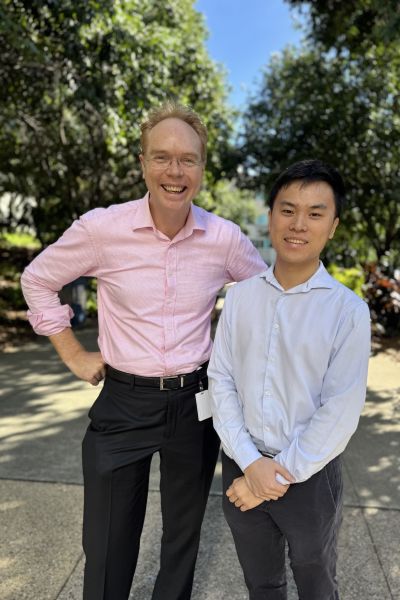Can AI lead to better hearing for Aboriginal and Torres Strait Islander children?

Research Director Dr Joel Dulhunty and RBWH Junior House Officer Dr Tony Lian are part of a team investigating whether AI can help Aboriginal and Torres Strait Islander children with ear disease.
Aboriginal and Torres Strait Islander children in rural and remote Australia have the highest rates of ear disease in the world. Clinician researchers at the Royal Brisbane and Women’s Hospital (RBWH) are working to close this gap in healthcare using artificial intelligence (AI).

Research Director Dr Joel Dulhunty and RBWH Junior House Officer Dr Tony Lian are part of a team investigating whether AI can help Aboriginal and Torres Strait Islander children with ear disease.
Undetected ear disease in children can have a range of impacts including hearing difficulties, delays in language development, academic performance impacts, decreased participation in school, social activities, community and the workforce, increased risk of interactions with the criminal justice system and an overall reduction in quality of life.
For children living in these rural and remote communities, limited access to specialist services means a telehealth approach is typically used to diagnose a range of health conditions including ear disease. Unfortunately, this approach suffers from delays between data capture, specialist review and treatment initiation.
RBWH Junior House Officer Dr Tony Lian, RBWH Ear, Nose and Throat (ENT) Registrar Dr Al-Rahim Habib and their collaborative team, including the Department of Otolaryngology at Westmead Hospital, have set out to find a better solution to diagnose and treat children living in rural and remote areas, in consultation with Aboriginal and Torres Strait Islander community and health service representatives.
“We found that AI algorithms can provide an instant point-of-contact diagnosis using a single eardrum camera image. Our group has developed a world-first AI algorithm, DrumBeat.ai, which has the same diagnostic accuracy as an ENT specialist,” Dr Lian said.
“We trained the algorithm using over 10,000 eardrum images collected over 10 years from Indigenous children living in rural and remote locations across the Northern Territory and Queensland.
“We are now moving to the next phase of the research where we are trialling the algorithm to test its usefulness and acceptance by healthcare workers, patients, parents/guardians and Indigenous communities.
“If successful, the DrumBeat.ai algorithm will be rolled out nationwide, with the potential to close the gap on this intractable public health crisis and provide an opportunity for more equitable distribution of healthcare resources.”
The project also aims to empower local health workers by providing them with a decision support tool to instantly identify and triage ear disease and detect hearing loss.
“We hope this will assist in improving their diagnostic capabilities with traditional methods and improve patient and family understanding of ear disease using digital imaging accompanying this program,” Dr Lian said.
“Overall, it is hoped the project will build the capacity of Indigenous health workers and other primary healthcare clinicians. Precious healthcare resources can be re-allocated towards supporting treatment rather than triage.”
